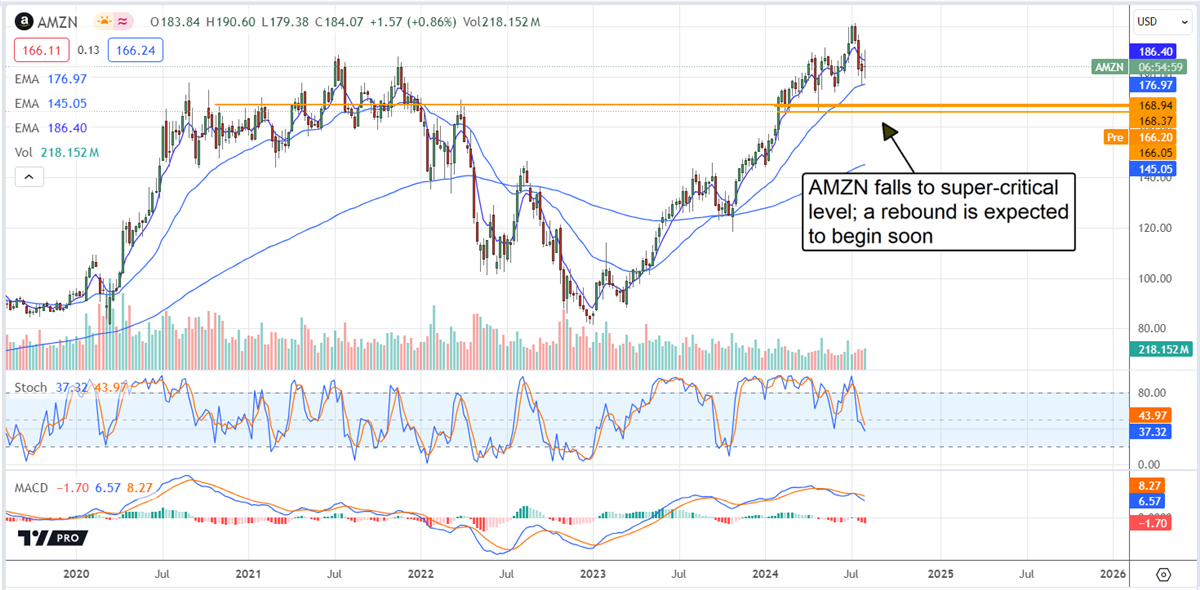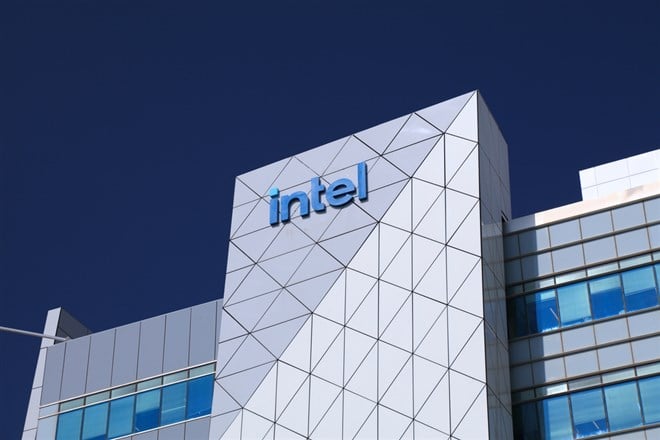Ticker Reports for August 4th
Intel Loses a Quarter of Its Value After Horrible Earnings Report
Intel (NASDAQ: INTC) has historically been one of the world’s leading semiconductor companies. That position has changed, especially after considering its Q2 2024 earnings, released on Aug 1, 2024. Shares plummeted the day after the release, declining over 25%. The firm has now lost over half of its value since 2024 began. First, we'll check out the firm's annual filing to see how it's operating, then break down the release. We'll look at some strategic mistakes Intel has made and examine potential ways to fix them. Lastly, we'll take a look at the latest Wall Street analysts' price targets.
Intel’s Segments: It’s All About the CPUs
Intel’s business operates as three reportable segments: the Client Computing Group (CCG), Data Center and AI (DCAI), and Network & Edge (NEX).
CCG primarily revolves around the development and sale of personal computer central processing units (CPUs). These are the “brains” of computers that perform calculations and run applications. It accounted for 54% of revenue in 2023 but was the firm’s only profitable segment in the year. It had an operating margin of 22%.
DCAI also manufactures processors but sells them to large enterprises for running their cloud software in large data centers. It accounted for 29% of revenue.
NEX designs processors for edge computing, which process data close to the source where it is generated rather than sending it back to a data center. This is essential for industries like autonomous driving, which need computers to make decisions quickly and succeed. It made up 11% of revenue.
Advanced Micro Devices (NASDAQ: AMD) is Intel's biggest competitor.
Intel’s Massively Disappointing Earnings Release
The company announced a wave of bad news in its earnings results.
The company fell drastically short of adjusted earnings per share (EPS) estimates. Their figure came in at $0.02, compared to the $0.10 expected. Adjusted EPS declined 84% from a year ago. Revenue came in at $150 million below expectations at $12.83, down 1% from a year ago.
Another damaging piece of news was the company’s Q3 adjusted EPS guidance, which it pinned at a loss of $0.03 per share. Analysts expected income of $0.31 per share.
Intel also plans to reduce costs significantly. It announced a plan is underway to reduce operating expenses and capital expenditures by $10 billion in 2025. This cost reduction will include a "greater than 15%" cut in staff. The firm plans to implement most of this headcount cut by the end of 2024.
Lastly, the firm said it would suspend its $0.50 per share annual dividend starting in Q4.
Intel’s Strategic Errors and Decline
Intel doesn’t seem to have a great plan to climb out of the hole it has dug for itself. Problems might very well start at the top of the organization. Since CEO Pat Gelsinger took the helm in 2021, shares are down 65%. In the three years starting in 2018, shares were up 36%.
The company has made strategic errors, especially with its delay in entering the data center graphics processing unit (GPU) market. GPUs are simply much more important when it comes to AI data processing than CPUs and come with a higher profit margin.
NVIDIA (NASDAQ: NVDA) has been in this market for years and now has a massive advantage. NVIDIA’s operating margin sits at 60% compared to 1% for Intel. Intel is even losing its advantage in data center CPUs. The company’s market share for these products declined by 5.6% from the previous year, which AMD took from it.
Intel’s Band-Aid Solutions Won’t Fix the Problem
Intel has been moving in the wrong direction in nearly every way. The company is likely making a good decision to cut its dividend so that it can reinvest cash into growth areas.
The decision to cut staff could also be appropriate, depending on how they redeploy their workforce afterward, but it will also cause turmoil in the short term. These moves feel a bit desperate, making it look like the firm is doing something to change without fixing the root problem.
A solid argument can be made that leadership needs to change so the firm can survive and take advantage of opportunities to thrive. It has done the opposite in the current CEO’s tenure.
An abundance of Wall Street analysts dropped price targets for Intel after the earnings release. Among those 24 analysts, the company’s new average price target is $26.45, which implies an upside of 25%.
Alex's "Next Magnificent Seven" Stocks
Today Alex Green is releasing his new breakdown of AI's "Next Magnificent Seven."
So please make some time to watch it.
Should You Invest in Bitcoin? Pros and Cons
Founded on the principles of blockchain technology, Bitcoin has captured investors’ attention, sparking debates about its potential as a viable investment option. While the allure of high returns has drawn many to Bitcoin, understanding its complexity, inherent volatility, and potential risks is crucial for investors seeking to make informed decisions.
What Is Bitcoin?
Unlike traditional currencies, Bitcoin is a decentralized digital currency not controlled by any single entity, making it resistant to government interference or manipulation. This decentralized nature has contributed to Bitcoin's popularity, as users value its potential for greater financial freedom and privacy.
Bitcoin transactions are recorded on a public distributed ledger known as the blockchain, which allows for transparency and immutability. Each transaction is verified and added to the blockchain through a process called "mining," where computers solve complex mathematical problems to secure the network and validate transactions. This process consumes significant computing power and energy, which has become a subject of environmental concern for the currency.
Since its inception in 2009, Bitcoin has experienced a remarkable rise in popularity, becoming a global phenomenon. Its value has fluctuated significantly, witnessing periods of explosive growth and sudden corrections. This volatility has attracted investors seeking high returns and those apprehensive of its potential for substantial losses.
What Are the Pros of Investing in Bitcoin?
Historically, Bitcoin has delivered substantial returns to early adopters, experiencing a significant increase in price since its inception, making it attractive for investors. Let’s take a look at some other reasons investors are incorporating this digital currency into their portfolios:
- Limited Supply: Only 21 million Bitcoins will be created, making it a scarce asset. This scarcity can increase its value over time, particularly if demand increases.
- Increasing Utility: Many merchants and companies now accept Bitcoin as a payment form, expanding its use beyond speculation and enhancing its legitimacy as a value holder.
- Inflation Hedge: Bitcoin's decentralized nature means it is not subject to the same inflationary pressures as traditional fiat currencies, potentially preserving purchasing power during economic uncertainty. However, Bitcoin's effectiveness as an inflation hedge remains debatable, as external factors and market sentiment still influence its price.
- Transparency and Security: Bitcoin operates without a central authority, offering investors security and autonomy. Its transactions are recorded on a transparent, public ledger (blockchain), which enhances accountability and helps build trust in the system.
- Global Accessibility: Bitcoin is accessible to anyone with an internet connection, regardless of location or financial background, allowing for global participation.
What Are the Cons of Investing in Bitcoin?
While there are many advantages of investing in Bitcoin, it is critical to understand the inherent volatility and risks associated with the digital currency and cryptocurrency market.
- Price Volatility: Bitcoin's price is subject to significant and rapid fluctuations, creating a high-risk environment for investors seeking stability. These fluctuations are amplified by the cryptocurrency market's lack of regulatory oversight, making it susceptible to fraud, manipulation, and price bubbles.
- Lack of Regulatory Oversight: The absence of regulation creates a situation where market sentiment and speculative activity can drive price movements, potentially leading to rapid price increases (bubbles) followed by equally swift declines. This dynamic underscores the inherent risk of significant losses in Bitcoin investments.
- Market Sentiment and Speculation: The absence of regulation allows market sentiment and speculative activity to drive price movements, leading to rapid price increases (bubbles) and swift declines, exposing investors to significant losses.
- Security Concerns: Digital wallets, which store, manage, and transact Bitcoin, are vulnerable to hacking and fraudulent activity. The loss of a private key, a unique code used to access a digital wallet, can result in the loss of all associated Bitcoin.
- Complexity of Storage and Security: Understanding the different types of digital wallets (hardware, software, online) and the intricacies of private key management and security protocols can be overwhelming for those unfamiliar with cryptocurrency technology.
- Lack of Consumer Protection: Unlike traditional financial instruments, Bitcoin transactions are generally irreversible, making unauthorized transactions or scams difficult to reverse or recover.
- Environmental Concerns: Bitcoin mining is energy-intensive, contributing to greenhouse gas emissions and raising concerns about Bitcoin's operation's sustainability and environmental impact.
How to Invest in Bitcoin?
Investing in Bitcoin requires a systematic approach, encompassing several critical steps to ensure security and effective investment management.
1. Acquire a Digital Wallet
A digital wallet is a software application that facilitates Bitcoin storage, transmission, and receipt. Several wallet types exist, each with its security features and functionalities, and selecting a wallet that aligns with your security preferences and risk tolerance is crucial.
- Hardware Wallets: Physical devices that store your Bitcoin offline, making them highly secure against online threats.
- Software Wallets: Applications stored on a computer or mobile device.
- Online Wallets: Accessible via the internet.
2. Purchase Bitcoin through a Cryptocurrency Exchange
Once a digital wallet is established, you can purchase Bitcoin through a cryptocurrency exchange, a platform that acts as a marketplace for buying, selling, and trading cryptocurrencies. Numerous exchanges operate in the market, each with varying fees, security features, and available cryptocurrencies.
Choosing a reputable exchange with strong security measures is paramount to protecting your funds and ensuring a secure trading experience. Before choosing a platform, it is essential to conduct careful due diligence on the exchange's security protocols, regulatory compliance, and user reviews.
3. Determine Your Investment Strategy
Following the acquisition of Bitcoin, you must determine their preferred investment strategy. Two common approaches are buying and holding or active trading.
- Buying and Holding: Purchase and hold Bitcoin long-term, expecting its value to appreciate over time. This strategy is suitable for long-term investment goals and lower risk tolerance.
- Active Trading: Buy and sell Bitcoin frequently to capitalize on short-term price fluctuations. This strategy requires a higher risk tolerance and a deeper understanding of market dynamics.
Ultimately, the choice of Bitcoin investment strategy should be aligned with your risk tolerance, financial goals, and time horizon.
4. Consider Investment Timing
Market sentiment, economic conditions, and technological developments influence Bitcoin's price. Monitoring market trends, financial data, and industry news is crucial to making informed entry and exit point decisions.
Investing in Bitcoin: A Balanced Perspective
Investing in Bitcoin requires carefully assessing both potential benefits and inherent risks. This is particularly true for emerging markets like cryptocurrencies, which often exhibit high volatility and lack regulatory oversight. While the prospect of high returns may be attractive, it is essential to approach such investments with a balanced perspective.
Ultimately, you must prioritize informed decision-making. Careful research, a thorough understanding of risks and potential rewards, and consultation with qualified financial advisors are essential for navigating the complexities of emerging markets. By embracing a balanced perspective and prioritizing responsible investment practices, individuals can make informed choices that align with their financial goals and risk tolerance.
Make Informed Decisions with MarketBeat
The cryptocurrency market, specifically Bitcoin, presents opportunities and challenges. To stay ahead of the curve, you need access to reliable information and insights to help you make informed decisions.
MarketBeat's tools and resources include data and analysis that enable you to track price movements and expert commentary, research reports, and insights from industry leaders. Visit MarketBeat today to explore the features and discover how they can empower your investment journey.
This $15 AI Stock is Too Good to Pass Up
This is the perfect AI stock...And it's currently trading for only $15.
With just one investment in this company, you could potentially set yourself up for massive financial gains.
Amazon Stock is Primed to Rebound Strongly After AI Bubble Bursts
An AI-inflated bubble is bursting in the market, and Amazon (NASDAQ: AMZN) is not immune, but don’t take this as an end to the rally. A bubble is bursting, but this is not the last vestige of an old and tired market we’re discussing. Instead, it is the frothy front edge of a wave that has yet to crash. One AI bubble is bursting, but there will be more as the tide of AI rolls onward, and it will take Amazon with it.
As tepid as the results and guidance may be, tepidness is in the eye of the beholder; there is nothing wrong with them other than failing to meet highly inflated expectations. Because Amazon is growing and showing strength in all segments, and AI is still a growing force in the tech economy, investors should expect this stock to rebound from these lows and do it strongly.
Analysts Give Mixed Response to Amazon News, Forecast 30% Upside
The analysts' response to Amazon’s Q2 release is mixed but does nothing to alter the outlook for higher share prices. Although more analysts lowered their targets than not, conviction is firming that a new all-time high will be set. The takeaway from the price target adjustments is that the range of targets is narrowing around the $210 to $220 levels, aligning with the pre-release consensus estimate, showing a firming belief this stock could advance 30% or more from the post-release lows. Moving to the new all-time high is also a significant technical move and could lead to increased momentum and a move above $230 by the end of the year.
Amazon is Firing on All Cylinders: Overeager Analysts Wanted More
Amazon is firing on all cylinders despite tepid performance relative to its consensus estimates. The company reported $148 billion in net revenue, missing the consensus by a slim 50 basis points but up 10.2% compared to last year. Strength was seen in the 9% gain in North America, Amazon’s largest segment, and in the 7% International growth (10% on an FX-neutral basis), but the real story is in AWS. AWS saw a 19% growth due to heightened demand for AI services and infrastructure, boosting its share of total revenue to 17.7%, an increase of 130 basis points.
Among the critical details is the margin. The margin widened significantly due to CEO Andrew Jassy and the team’s efforts, improving profitability across all segments. Operating margin grew by 91% on a 90% increase in North American margin, profitability in the International segment, and a 72% gain at AWS. The investment in RIVN positively impacted the results but was negligible and in the low single-digit range. What this means for the cash flow is a 75% increase and triple-digit gains for the free cash flow.
The detail that undercut the market is the guidance, which is solid but short of expectations. The company forecasted revenue in a range bracketing the consensus with consensus at the range’s high end, still an 8% to 11% gain versus last year. The guidance is likely cautious, assuming that AI spending continues to build momentum across the stack.
Amazon Falls To Super-Critical Support Level
The price action in AMZN shares is bearish following the release, pushing the stock down to a super-critical support target. That target is near the $165-$170 range, a pivotal price point for the last four years. It capped gains in 2020, 2021, and 2022 and was a critical pivot point in 2023, later retested for support in 2024. Now, the market is back, retesting support at that level again, and it is likely to be confirmed. In that scenario, it is only a matter of time until new highs are set. If not, shares of AMZN could fall to $160 or lower before finding firm support.







0 Response to "🌟 Amazon Stock is Primed to Rebound Strongly After AI Bubble Bursts"
Post a Comment